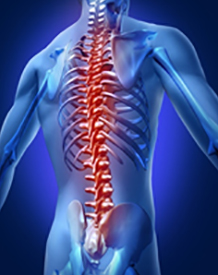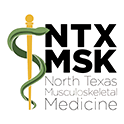Low back pain: an overview
The majority of individuals (about 65%) experience some form of low back pain at some point in their lives, making this condition second only to upper respiratory illness as a cause for visiting a physician.1,2 Many episodes of low back pain pass within a few weeks to a month (acute episode); however, individuals with continuous pain lasting 8 weeks or more after onset (chronic episode) will often have symptoms at 1 year.1,2 Low back pain as a chronic condition is a leading cause of disability worldwide.3
Low back pain itself is a symptom of a medical condition, not a diagnosis in itself. The low back is a complex network of spinal muscles, nerves, bones, discs and tendons in the lumbar spine that move together interdependently.4 Keeping this system mechanically aligned and held snuggly together allows for healthy function and pain-free movement. When the optimal function of the low back is compromised, pain will occur.
 Common causes of low back pain include:
Common causes of low back pain include:
- Irritation of large nerve roots that travel to the legs
- Irritation of smaller nerves in lower back
- Strain of large paired lower back muscles (erector spinae)
- Damage to bones, ligaments, or joints
- Degeneration of intervertebral discs
- Sprains that occur when the ligaments holding the vertebrae together develop micro-tears which causes loss of strength and results in laxity and misalignment
Nonspecific vs Radicular (sciatica)
Both acute and chronic low back pain can be further classified according to the presence of neurologic symptoms and signs.2
Nonspecific. If no neurologic symptoms and signs are present, the low back pain is considered nonspecific or non-radicular. That is, the pain is located in or around the spine and does not radiate into the leg(s). Nonspecific low back pain generally does not involve spinal nerve root compression, and its pathophysiology is typically difficult to determine through traditional imaging tests. Manual palpitation and physical range of motion assessment, however, are better able to locate sources of pain in soft tissue structure, thus able to accurately diagnose the cause of pain.
Radicular. Radicular low back pain (or radiculopathy) typically radiates into the leg(s) along the course of a spinal nerve root. Radicular pain is usually caused by compression, inflammation, and/or injury to a spinal nerve root, but other intraspinal pathologies can be a cause.2 The most common symptom of radicular pain is usually called sciatica or, sometimes, radiculopathy. This is a pain that radiates along the sciatic nerve down the back of the thigh.
Radicular pain/sciatica is further divided into two additional categories: (1) radicular pain caused by conditions of the spinal column itself that affect the nerves originating in the specified area and (2) pseudo-radiculopathy, or mechanical conditions that cause irritation to nerves creating symptoms similar to those of radiculopathy/sciatica. True radiculopathy occurs in very few cases of radicular lower back pain with the vast majority of nerve pain in the back caused by mechanical conditions, such as:
- Myofascial trigger points
- Piriformis syndrome
- Facet syndrome
Low Back Pain Management
Osteopathic Manipulation
Osteopathic Manipulation Treatment (OMT) is a system of hands-on techniques using manual pressure designed to evaluate and treat impaired function of the musculoskeletal system. OMT addresses the root biomechanical causes of injuries and conditions to alleviate pain and restore optimal function of the body. It is effective in treating muscle pain, joint injuries, and fascia dysfunction. Because OMT improves blood flow and opens lymphatic pathways through the body, it also helps to nourish tendons and ligaments, relieves stress, and aids in detoxification.
Regenerative Orthopedics
Cell-based therapies have created a renaissance in the treatment of orthopedic conditions. Platelet Rich Plasma Therapy (PRP) and Stem Cell Therapy promote and accelerate the body's natural healing process for soft tissue injuries and osteoarthritis. PRP is one of the first regenerative therapies for treatment of orthopedic conditions. Regenerative Therapies your own cells in concentrated doses to stimulate what your body does naturally. PRP and Stem Cell Therapy are also effective in reducing joint inflammation, helping to reverse the degenerative effects of osteoarthritis.
Adverse effects of cortisone
Treatment for low back pain varies with medical philosophical perspective. One of the key disputes centers on the use of corticosteroids, or cortisone. Epidural corticosteroid injections sometimes give immediate improvements in pain by reducing the inflammation that is causing it. They do not, however, address the root cause of the pain. Many studies show that cortisone can actually make the condition worse. And because inflammation is the body's natural way of healing, cortisone actually works against the natural healing process and can be harmful to tissue. Learn more about the adverse effects of Cortisone from Dr. Minotti's blog.
A large meta-analysis by the Pacific Northwest Evidence-based Practice Center on behalf of the US Agency for Healthcare Research and Quality (AHRQ)5 concluded that benefits of corticosteroid injections are small and improvements are not long lasting. Cortisone has also been shown to cause further damage to bone and joint tissue.
The published study is available on the PAIN Practice website.
Movement
Too much or too little movement can cause low back pain. Keeping the spinal column mechanically functional, free from obstructions and impingements, helps all of the body’s systems to function optimally. A healthy spine has long been considered a key to a longer, healthier life. Exercising this complex system, like any part of the body, maintains supple, pain-free movement.
 Yoga has long been established as a form of exercise to maintain healthy function of the spine. Though these are also exercises, they are different in their impact on the human body. Yoga improves flexibility and stabilizes core muscles.
Yoga has long been established as a form of exercise to maintain healthy function of the spine. Though these are also exercises, they are different in their impact on the human body. Yoga improves flexibility and stabilizes core muscles.
Dr. Pierce-Talsma, both a DO and certified yoga instructor, discusses the advantages of a more holistic approach to back pain,7 “We have to come at low back pain from a more holistic perspective… One of the pitfalls of low back pain treatment is that health care professionals often focus on a precise anatomic structure such as a disc or a facet joint, missing the bigger picture of functional anatomic relationships and kinematic chains.” Read more about the discussion with Dr. Pierce-Talsma.
To help understand the principles of managing low back pain for conditions originating within 6 weeks, Healthwise.net provides an interactive video to customize information for your individual back pain.
Princeton University Athletic Medicine provides an excellent series of exercises for back pain. Remember to be aware of the difference between a good hurt and a bad hurt and to start gently. If in doubt, stop and consult your physician.
Summary
- Low back pain is usually caused by mechanical disorders of the spine, with or without involvement of the spinal nerve roots, but it may be a result of nonmechanical causes or may be referred from retroperitoneal sources.
- Diagnosis starts with a careful examination, followed by consideration for neuroimaging studies and electrodiagnostic studies.
- Specific management decisions are based on the duration of symptoms and the presence or absence of neurologic deficits.
- Chronic pain syndromes are often perpetuated by nonmedical factors. Treatment requires a multidisciplinary approach.2
References
1) Andersson GBJ: Epidemiologic features of chronic low-back pain. Lancet. 1999;354:581-585. Available at: http://www.thelancet.com/journals/lancet/article/PIIS0140-6736(99)01312-4/abstract
2) Levin KH. Low back pain. Cleveland Clinic Center for Continuing Education. August 2010. Available at: http://www.clevelandclinicmeded.com/medicalpubs/diseasemanagement/neurology/low-back-pain/#top
3) Gordon S. Low back pain leading cause of disability: study. HealthDay. 2014. Available at: http://www.webmd.com/back-pain/news/20140325/low-back-pain-leading-cause-of-disability-worldwide-study#1
4) Ullrich PF. Lower back pain symptoms, diagnosis, and treatment. Spine-health. June 16, 2015. [Epub]. Available at: http://www.spine-health.com/conditions/lower-back-pain/lower-back-pain-symptoms-diagnosis-and-treatment
5) Chou R, Hashimoto R, Friedly J, et al. Pain management injection therapies for low back pain. Technology Assessment Report ESIB0813. (Prepared by the Pacific Northwest Evidence-based Practice Center under Contract No. HHSA 290-2012-00014-I.) Rockville, MD: Agency for Healthcare Research and Quality; July 2015. Available at https://www.ncbi.nlm.nih.gov/pubmedhealth/PMH0073206/
6) Singla V, Batra YK, Bharti N, et al. Steroid vs platelet-rich plasma in ultrasound-guided sacroiliac joint injection for chronic low back pain. Pain Practice. doi:10.1111/papr.12526 Available at: http://onlinelibrary.wiley.com/doi/10.1111/papr.12526/abstract
7) Raymond R. How yoga can help your patients with low back pain. The DO. 2016;September 19. Available at: http://thedo.osteopathic.org/2016/09/how-yoga-can-help-your-patients-with-low-back-pain/
